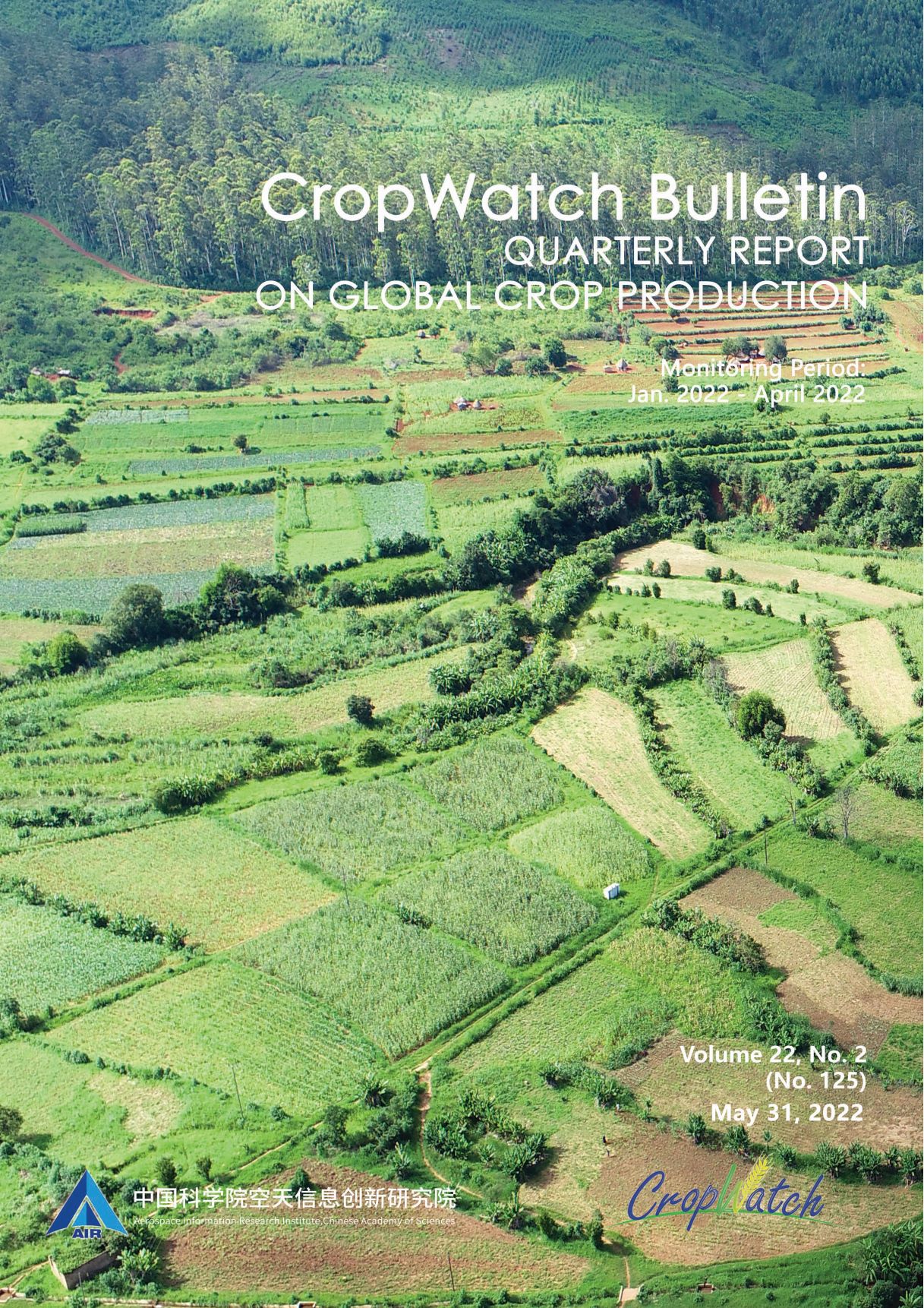
-
May 2022 CropWatch Bulletin is based mainly on current remote sensing inputs in addition to detailed and spatially accurate reference data about crops and their management. Focusing on the months of January to April 2022, chapters cover global, national, and regional level agroclimatic conditions and the condition of crops that were growing during this time. For China, the bulletin presents crop conditions for each of seven key agro-ecological zones, an updated estimate of trade prospects (import/export) of major crops. The focus section reports on the estimate by CropWatch for maize, rice, wheat and soybeans production in 2022, recent disaster events with an impact on agriculture, the possibility of an El Niño event and the impact of Russia Ukraine conflict on world food supply.
Key messages from the report:
- Temperatures keep raising, though at a slightly slower pace thanks to La Niña. Extreme high temperature in South Asia caused terminal heat stress and wheat yield reduction in India and Pakistan
- Russia Ukraine conflict brought uncertainties to world food supply. The production of winter crops increased in Ukraine while the conflicts may influence harvest
- Influenced by agroclimatic conditions, global maize and rice production is forecasted to rise while wheat and soybean decrease from 2021
- Benefitted from favorable weather conditions in recent two months, the crop more than compensated for the delayed sowing in last fall. But wheat production still decreases due to the reduced planted area
Introduction
This CropWatch bulletin summarizes global crop condition developments and agroclimatic factors from January 1 to April 30 of 2022 through 4 zoom in from a global overview of agroclimatic indicators (Chapter 1) to detailed descriptions of crop and environmental conditions in large production zones (Chapter 2), to individual country analyses covering 42 major producers and exporters including agro-ecological zones (Chapter 3) and China (Chapter 4). A special focus section is included in Chapter 5, presents crop production for 2022, disaster events, update on El Niño or La Niña and the impact of the Russia Ukraine conflict on global food security. This first part of the report includes the cover, table of contents, abbreviations, a short overview of the different sections of the bulletin and executive summary.DownloadChapter 1. Global agroclimatic patterns
Chapter 1 describes the CropWatch Agroclimatic Indicators (CWAIs) rainfall (RAIN), temperature (TEMP), and radiation (RADPAR), along with the agronomic indicator for potential biomass (BIOMSS) in sixty-five global Monitoring and Reporting Units (MRU). RAIN, TEMP, RADPAR and BIOMSS are compared to their average value for the same period over the last fifteen years (called the “average”). Indicator values for all MRUs are included in Annex A table A.1. For more information about the MRUs and indicators, please see Annex B.DownloadChapter 2. Crop and environmental conditions in major production zones
Chapter 2 presents the same indicators—RAIN, TEMP, RADPAR, and BIOMSS— as those used in Chapter 1, and combines them with the agronomic indicators—cropped arable land fraction (CALF), maximum vegetation condition index (VCIx), and minimum vegetation health index (VHIn)— to describe crop condition in six Major Production Zones (MPZ) across all continents. For more information about these zones and methodologies used, see the quick reference guide in Annex B.DownloadChapter 3. Main producing and exporting countries
Chapter 1 has focused on large climate anomalies that sometimes reach the size of continents and beyond. The present section offers a closer look at individual countries, including the 42 countries that together produce and commercialize 80 percent of maize, rice, wheat, and soybean. As evidenced by the data in this section, even countries of minor agricultural or geopolitical relevance are exposed to extreme conditions and deserve mentioning, particularly when they logically fit into larger patterns.DownloadChapter 4. China
This chapter starts with a brief overview of the agro-climatic and agronomic conditions in China over the reporting period (section 4.1). Section 4.2 provides detailed analysis of the winter wheat planted area, projected yield and production as well as the total winter crops production. The early rice planted area is also estimated by integration of optical and SAR data over the major producing provinces. Next it describes the situation by region, focusing on the seven most productive agro-ecological regions of the east and south: Northeast China, Inner Mongolia, Huanghuaihai, Loess region, Lower Yangtze, Southwest China, and Southern China (4.3). Section 4.4 describes trade prospects (import/export) of major crops. Additional information on the agroclimatic indicators for agriculturally important Chinese provinces are listed in table A.11 in Annex A.DownloadChapter 5. Focus and perspectives
Building on the CropWatch analyses presented in chapters 1 through 4, this chapter presents food production prediction for 2022 (section 5.1), as well as sections on recent disaster events (section 5.2), an update on El Niño or La Niña (5.3) and the impact of the Russia Ukraine conflict on global food security (5.4).DownloadAnnex A. Agroclimatic indicators
Tables in this Annex provide additional information about the agroclimatic indicators—RAIN, TEMP, and RADPAR—as well as BIOMSS for the various CropWatch spatial units. Those units include the Mapping and Reporting Units (MRU); the forty-three main producing and exporting countries; and regions or provinces within large countries—Argentina, Australia, Brazil, Canada, India, Kazakhstan, Russia, and the United States; and China.DownloadAnnex B. Quick reference guide to CropWatch indicators, spatial units and methodologies
Annex B presents a brief overview of the CropWatch indicators and spatial units (including the MRUs, MPZs, and countries), along with a description of the CropWatch production estimation methodology and methodology to determine the severity of the occurrence.Download

